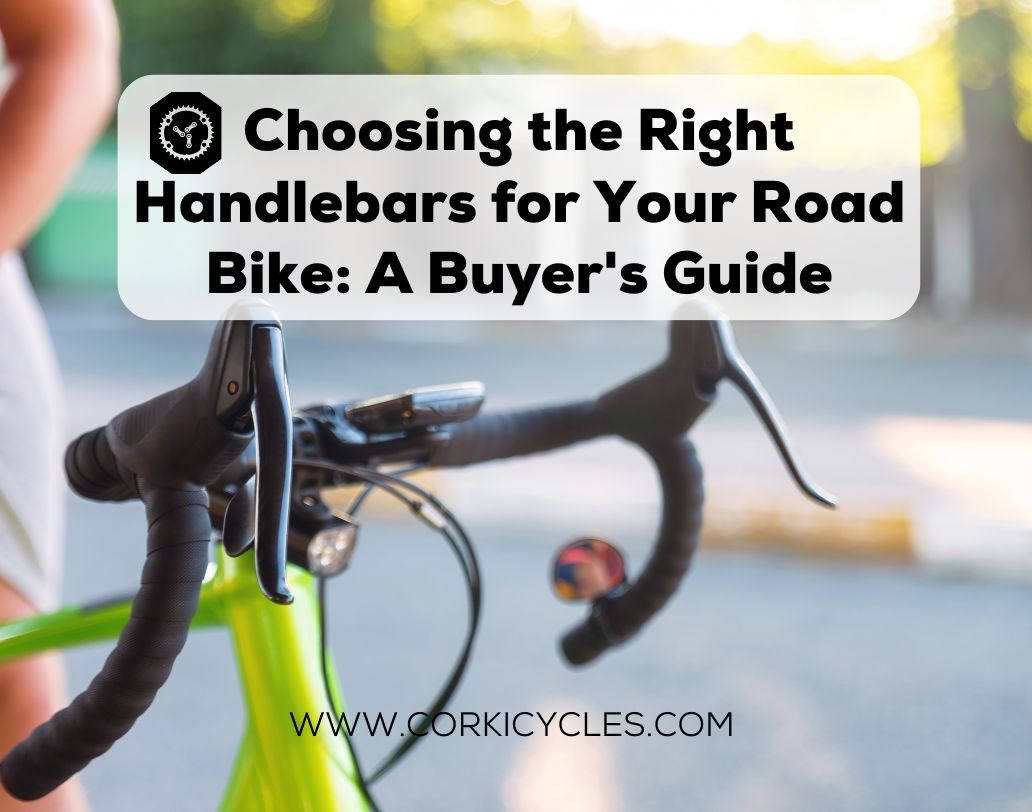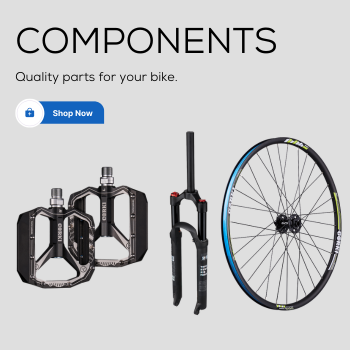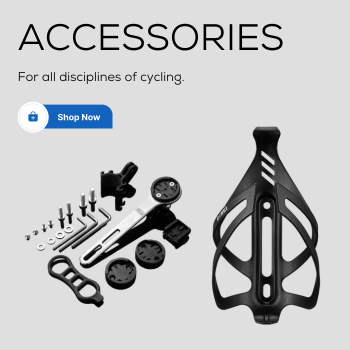
Choosing the Right Handlebars for Your Road Bike: A Buyer's Guide
Handlebars are an essential component of any road bike, serving as a crucial interface between the rider and the bicycle. They play a significant role in determining comfort, control, and overall performance while cycling.
In road biking, where efficiency and speed are paramount, selecting the right handlebars can make a significant difference in your riding experience. Whether you're cruising along scenic routes, tackling challenging climbs, or sprinting towards the finish line, the choice of handlebars can profoundly impact your comfort, handling, and efficiency.
In this guide, we will delve into the various types of handlebars commonly used in road biking, exploring their features, benefits, and drawbacks. Additionally, we'll discuss essential factors to consider when making your selection, including riding style, comfort, aerodynamics, and material construction.
Whether you're a seasoned road cyclist looking to optimize performance or a beginner seeking guidance on your first bike setup, this comprehensive guide will provide valuable insights to help you make an informed decision. So, let's dive in and discover the handlebars that best suit your riding needs and preferences.
Understanding Different Types of Road Bicycle Handlebars
Alright, let's dive into the world of handlebars! Just like there are different kinds of pizza toppings to suit every taste bud, there are various types of handlebars to match your riding style. Let's check them out:

Drop Handlebars
Drop handlebars are like the cool kids of the biking world. It is usually found on road bikes and gravel bikes. They're curved downwards and backward, giving you multiple hand positions to grip onto. You can ride on the tops for a relaxed posture, on the hoods for a more casual feel, or down in the drops for that aerodynamic speed boost. This type of handlebar offers aerodynamics but has disadvantages in terms of comfort.
Advantages and Disadvantages: Drop handlebars are super versatile. You can tweak your grip depending on the terrain or how fast you want to go. Plus, they're great for cutting through the wind, making them a favorite for road racers. The downside? Well, they might not be the comfiest option for everyone, especially if you spend long hours on the bike.
Flat Handlebars
Flat handlebars are straightforward and, well, flat! They're typically seen on mountain bikes, but you can find them on some road bikes too. They give you a more upright riding position, perfect for soaking in the scenery or navigating tricky trails.
Advantages and Disadvantages: Flat handlebars are all about control and comfort. You've got plenty of leverage for steering and tackling rough terrain. Plus, they're usually wider, giving you more stability. On the flip side, if you're chasing speed records on the road, you might miss the aerodynamic benefits of drop bars.
Flared Handlebar

Flared handlebars are a type of road bike handlebar where the drops flare outwards, away from the bike's centerline. It’s wider at the drop than at the top. These flared bars are usually used on gravel bikes. These types of bikes are designed for riding on diverse terrain, including gravel roads, dirt trails, and rough surfaces. The shape of the flared handlebars provides riders with better handling, particularly in challenging off-road conditions.
Other Specialized Handlebar Types
Alright, buckle up because we're not done yet! There are plenty of other handlebar styles out there, like bullhorn bars that curve forward like, well, bullhorns. Aero handlebars are also commonly used on road bikes. They're designed to reduce air resistance and boost speed, especially for racing and fast riding. These handlebars usually have a sleek shape that lets riders get into a more aerodynamic position, like lying flat on the handlebars to cut through the air. You can add it to drop handlebars as an accessory.
Then there are riser bars that, you guessed it, rise higher than flat bars, giving you a more upright position. And let's not forget compact bars, which are like a mix between drop and flat bars, offering a bit of everything.
Each of these handlebar types has its own unique vibe and purpose, so don't be afraid to experiment and find what feels best for you. After all, the handlebars are your bike's way of saying, "Let's roll!"
Factors to Consider When Choosing Road Bike Handlebars
Alrighty, let's talk about the nitty-gritty stuff – choosing the handlebars that'll make your biking dreams come true. Here are some things to think about:
Riding Style and Goals
First things first, what kind of rider are you? Are you all about cruising down scenic routes, hitting the trails, or zooming through time trials? Your riding style and goals will play a big role in picking the perfect handlebars.
Comfort and Fit
Now, let's get comfy! Your handlebars should feel like an extension of your arms, not like an awkward handshake. Here are a few things to consider for that perfect fit:
- Reach: Different handlebar designs would normally have different reaches. Reach is the distance from the horizontal part of the handlebar to the furthest edge of the drops and determines how far away the levers will be placed. The farther forward, the further the arm reaches forward when holding the lever. Bigger riders will need a more extended reach while shorter riders will be more comfortable with a smaller figure. Make sure the reach is ideal, so that the body doesn’t stick out too much.
- Drop: After choosing a reach, also make sure the handlebar you want has the ideal drop curve. The drop of a road bike handlebar is basically how much lower the ends of the handlebar are compared to the top part where you usually hold onto. It's like the difference in height between standing tall and bending down a little bit. This drop gives you options for different hand positions while riding, like when you're cruising along on the flat part or grabbing onto the lower part for a more aerodynamic stance. The farther the distance, the more bent our bodies are in the aero position (hold down).
- Width: When it comes to choosing the right width for your road bike handlebars, it's a bit like finding the perfect pair of shoes. It is not too wide, not too narrow, but just right. Some folks say to match your shoulder width, but that's not always the best guide.
For road bikes, narrower handlebars are usually the go-to. They help you slice through the wind and feel like a speed demon. Improve the speed on the road. But the wider handlebar slows steering and can offer stability and confidence to an inexperienced rider, regardless of their size or shoulder width.
So, try out different widths to see what feels best for you. For example, you're riding with a 40cm handlebar and want to kick up the speed. You might consider switching to a narrower one, like 38cm or even 36cm. However, the best way to find the perfect handlebar width is by using a bike fitting. Trust me, it's the best move you can make.
Picking the right handlebar width is all about finding what feels good. While shoulder width can help as a starting point, it's not the only thing to think about. So, listen to your body, try out different options, and don't be afraid to ask for help. Once you find the perfect fit, you'll be cruising in style!
Weight
Every ounce counts, especially if you're aiming for that feather-light ride. While handlebars might not be the heaviest part of your bike, every little bit of weight savings adds up, so keep an eye on those numbers if you're a weight weenie.
Material
Last but not least, let's talk about the material of the road bike handlebar. Carbon and aluminum are typically used on road bikes. Carbon handlebars are becoming an increasingly common sight on high-end road bikes. They’re lighter and stronger than other handlebars, making the bike easier to maneuver. Moreover, carbon also naturally dampens vibrations, so it can be a more comfortable option.
However, carbon handlebars are more expensive than aluminum handlebars. For the relative cost, humble aluminum bars offer essentially the same performance at a much lower cost.
Conclusion
Alright, folks, we've covered a lot of ground here – from the different types of handlebars to the nitty-gritty details of choosing the right one for you. After reading this guide on choosing handlebars, you can determine the right size, shape, and material according to your needs for road cycling. If you have other questions about mountain bike handlebars, please read this blog: " What's the Difference Between MTB Handlebars?" This article can help you understand the mountain bike handlebar.
So, go ahead, hit the road, and enjoy the ride! If you have questions or want to share your biking stories, please drop them below. Happy riding!




